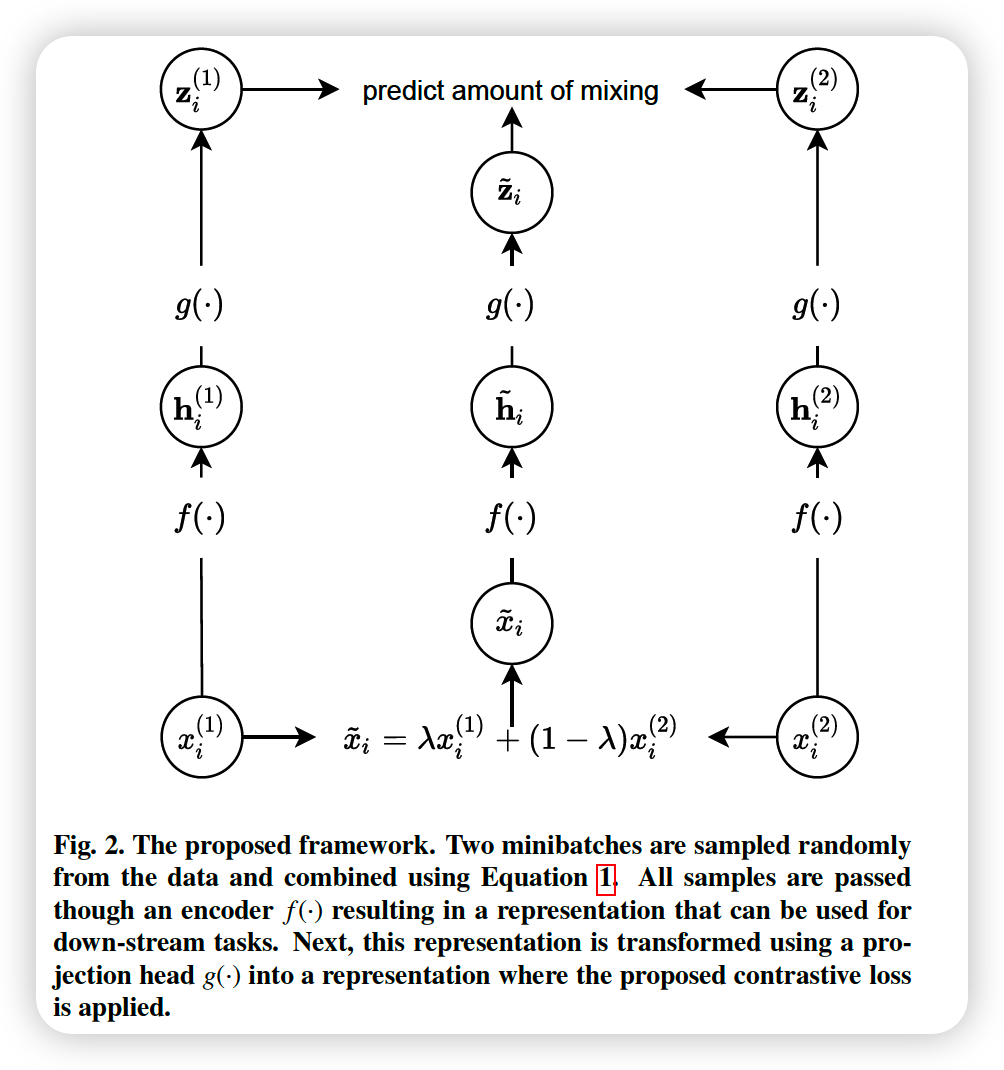Mixing Up Contrastive Learning : Self-Supervised Representation Learning for TS (2022)
Contents
- Abstract
- Introduction
- Mixup Contrastive Learning
- Novel Contrastive Loss
0. Abstract
lack of labeled data
\(\rightarrow\) need for UNsupervised representation framework
propose an UNSUPERVISED CONTRASTIVE LEARNING framework,
-
motivated from the perspective of label smoothing
-
use a novel contrastive loss,
-
That exploits a data augmentation scheme
( = new samples : generated by mixing 2 data samples )
-
-
task : predict the mixing component
( = which is utilized as soft targets in the loss function )
1. Introduction
Contrastive Learning
-
self-supervised reprsentation learning
-
key : discriminate between different view of the sample
-
different view = created via data augmentation
( exploit prior information about the structure in the data )
-
data augmentation :
- usually done by injecting noise
-
Data Augmentation for TS
- more challengfing, due to…
- (1) heterogeneous nature of TS data
- (2) lack of generally applicable augmentations
Mixup
-
recent data augmentation scheme
-
creates an augmented sample, via…
\(\rightarrow\) convex combination of 2 data poionts & mixing component
Proposed framework
- Task : predict the strength of the mixing component,
- based on the “2 data points & augmented samples”
- motivated by LABEL SMOOTHING
- concept of adding noise to the labels
- soft target : between 0~1
2. Mixup Contrastive Learning
explain based on UTS (Univariate Time Series)
- \(x=\{x(t) \in \mathbb{R} \mid t=1,2, \cdots, T\}\).
Common approach in Contrastive learning
- ENCODER : \(x \rightarrow z\)
- encoder is trained by passing different augmentations of the SAME sample
- goal of contrastive learning
- embed similar samples in close proximity by exploiting the INVARIANCES in the data
- after training, discared except ENCODER
Data Augmentation
- create new samples via convex combinations of training examples ( = Mixup )
- 2 time series ( \(x_i\) & \(x_j\) ) drawn randomly from data
- \(\tilde{x} = \lambda x_i + (1-\lambda) x_j\).
- \(\lambda \in [0,1]\) : mixing parameters
- \(\lambda \sim \text{Beta}(\alpha, \alpha)\) & \(\alpha \in (0, \infty)\)
- \(\lambda \in [0,1]\) : mixing parameters
\(\rightarrow\) task : predicting hard 0 & 1 targets to soft targets \(\lambda\) & \(1-\lambda\)
\(\rightarrow\) lead to increased performance & less overconfidence
(1) Novel Contrastive Loss
At each training iteration….
- (step 1) new \(\lambda\) is drawn ( from Beta distn )
- (step 2) draw 2 minibatches, of size \(N\)
- (2-1) \(\left\{x_{1}^{(1)}, \cdots, x_{N}^{(1)}\right\}\)
- (2-2) \(\left\{x_{1}^{(2)}, \cdots, x_{N}^{(2)}\right\}\)
-
(step 3) create a new minibatch of AUGMENTED samples
- \(\left\{\tilde{x}_{1}, \cdots, \tilde{x}_{N}\right\}\).
-
(step 4) pass 3 minibatches to ENCODER \(f(\cdot)\)
- (1) \(\left\{\mathbf{h}_{1}^{(1)}, \cdots, \mathbf{h}_{N}^{(1)}\right\}\)
- (2) \(\left\{\mathbf{h}_{1}^{(2)}, \cdots, \mathbf{h}_{N}^{(2)}\right\}\)
- (3) \(\left\{\tilde{\mathbf{h}}_{1}, \cdots, \tilde{\mathbf{h}}_{N}\right\}\)
( those three can be used for downstream tasks )
-
(step 5) transform 3 mini batches into task-dependent representation
- (1) \(\left\{\mathbf{z}_{1}^{(1)}, \cdots, \mathbf{z}_{N}^{(1)}\right\}\)
- (2) \(\left\{\mathbf{z}_{1}^{(2)}, \cdots, \mathbf{z}_{N}^{(2)}\right\}\)
- (3) \(\left\{\tilde{\mathbf{z}}_{1}, \cdots, \tilde{\mathbf{z}}_{N}\right\}\)
Proposed Contrastive loss for a single instance :
\(l_{i}=-\lambda \log \frac{\exp \left(\frac{D_{C}\left(\tilde{\mathbf{z}}_{i}, \mathbf{z}_{i}^{(1)}\right)}{\tau}\right)}{\sum_{k=1}^{N}\left(\exp \left(\frac{D_{C}\left(\tilde{\mathbf{z}}_{i}, \mathbf{z}_{k}^{(1)}\right)}{\tau}\right)+\exp \left(\frac{D_{C}\left(\tilde{\mathbf{z}}_{i}, \mathbf{z}_{k}^{(2)}\right)}{\tau}\right)\right)}\) \(-(1-\lambda) \log \frac{\exp \left(\frac{D_{C}\left(\tilde{\mathbf{z}}_{i}, \mathbf{z}_{i}^{(2)}\right)}{\tau}\right)}{\sum_{k=1}^{N}\left(\exp \left(\frac{D_{C}\left(\tilde{\mathbf{z}}_{i}, \mathbf{z}_{k}^{(1)}\right)}{\tau}\right)+\exp \left(\frac{D_{C}\left(\tilde{\mathbf{z}}_{i}, \mathbf{z}_{k}^{(2)}\right)}{\tau}\right)\right)}\),
- where \(D_{C}(\cdot)\) denotes the cosine similarity and \(\tau\) denotes a temperature parameter

